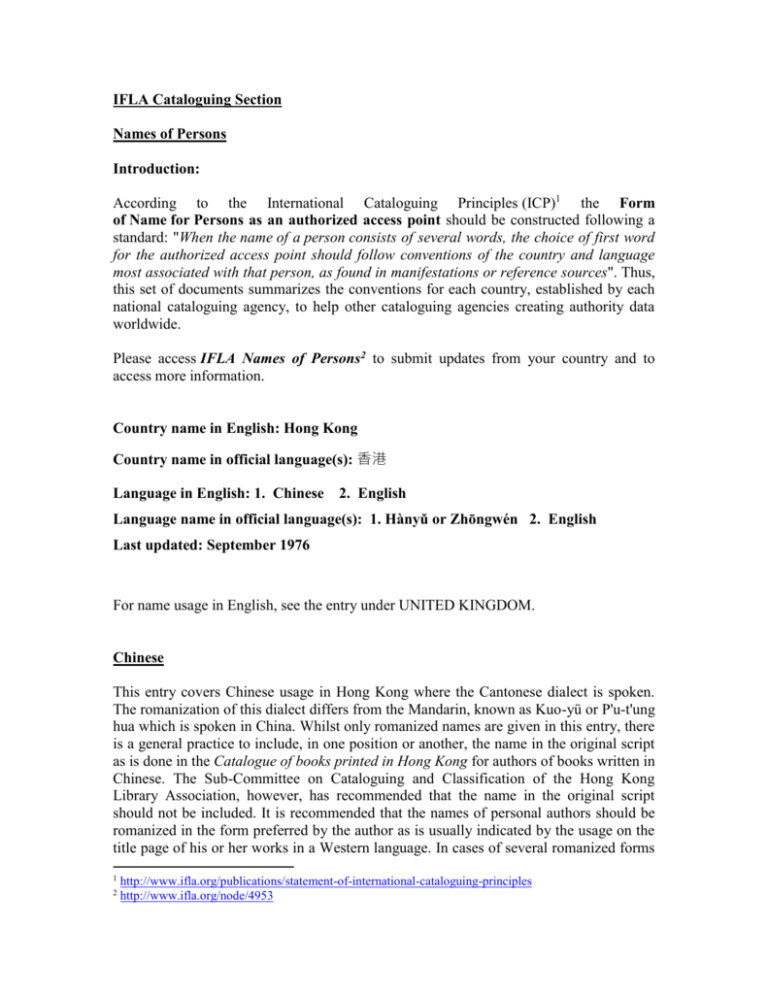Names of Persons - Hong Kong
advertisement

IFLA Cataloguing Section Names of Persons Introduction: According to the International Cataloguing Principles (ICP)1 the Form of Name for Persons as an authorized access point should be constructed following a standard: "When the name of a person consists of several words, the choice of first word for the authorized access point should follow conventions of the country and language most associated with that person, as found in manifestations or reference sources". Thus, this set of documents summarizes the conventions for each country, established by each national cataloguing agency, to help other cataloguing agencies creating authority data worldwide. Please access IFLA Names of Persons2 to submit updates from your country and to access more information. Country name in English: Hong Kong Country name in official language(s): 香港 Language in English: 1. Chinese 2. English Language name in official language(s): 1. Hànyǔ or Zhōngwén 2. English Last updated: September 1976 For name usage in English, see the entry under UNITED KINGDOM. Chinese This entry covers Chinese usage in Hong Kong where the Cantonese dialect is spoken. The romanization of this dialect differs from the Mandarin, known as Kuo-yü or P'u-t'ung hua which is spoken in China. Whilst only romanized names are given in this entry, there is a general practice to include, in one position or another, the name in the original script as is done in the Catalogue of books printed in Hong Kong for authors of books written in Chinese. The Sub-Committee on Cataloguing and Classification of the Hong Kong Library Association, however, has recommended that the name in the original script should not be included. It is recommended that the names of personal authors should be romanized in the form preferred by the author as is usually indicated by the usage on the title page of his or her works in a Western language. In cases of several romanized forms 1 2 http://www.ifla.org/publications/statement-of-international-cataloguing-principles http://www.ifla.org/node/4953 appearing in different works reference sources should be consulted to determine the best known form. When a Cantonese romanization is used reference is always made from the standard Wade-Giles romanization, as well as any other variants which may be sought. NAME ELEMENTS Elements normally forming part of a name Element 1. Family name Type simple, character Examples usually one Lam Lai Wong Chan compound, usually two Au-Yeung characters which may be Szeto hyphenated or written as one word 2. Personal name usually two but sometimes Yuen-kwok one Chuen-yan Yuk-long Hok-lam Tin 3. Additional forename, usually one or more of William increasingly coming into Western origin or Leusana use equivalent Note: In Hong Kong wholly Chinese names are written as Lee Hon-ling family name followed by person name. However, Hong Kong Chinese writing in Western Hon-ling Lee languages, and Chinese living in other countries, frequently reverse this order. When a Western forename is used with a name its position Henry Lee Hon-ling depends on the person’s background, e.g., in Hong Kong or even, with possible use of comma, as in Western Lee Hon-ling, Henry countries and publications. Henry Hon-ling Lee Hon-ling Henry Lee Additional elements to names Element Use 1. Temple name forming added to dynastic name part of royal name 2. Religious title after the personal name Examples Ming T’ai-tsu Fa-hsien, Shih ORDER OF ELEMENTS IN CATALOGUE HEADINGS General rule Type of name Entry element 1. Simple and compound family name family name A Western additional name should follow the Chinese personal name(s) and if the name in the original script is to be given it should follow the Chinese personal name(s). If the personal names are given as initials, and the full form is not known, the Western name and initials should be given in the order on the title page. 2. Name of married woman husband’s family name consisting of her husband’s followed by maiden name family name followed by her maiden name 3. Royal name dynastic name in direct order 4. Religious name religious personal name Examples LAM, Yuen-kwok, William AU-YEUNG, Kin-ching LAI, Chuen-yan, David TSUN, King-yim WANG MA, Hsi-ch’un MING T’AI-TSU, Emperor of China Note: It is necessary to make references from the person name (Chu, Yuanchang), the reign title (Hung-wu), and the dynastic name and reign title (Ming Hung-wu). FA-HSIEN, Shih National cataloguing code The Anglo-American cataloguing rules are widely used in Hong Kong. Romanization schemes in use Cantonese: The student’s Cantonese-English dictionary by B. F. Meyer and T. F. Wempe. 3rd ed. - New York, 1947. Modern standard Chinese (Mandarin or Kuo-yü): A Chinese-English dictionary by Herbert A. Giles. - 2nd ed. - London, 1912. (Based on modifications to the system devised by Sir Thomas Francis Wade) Mathews’ Chinese-English dictionary. - Cambridge, Massachusetts, 1943. (A modified Wade-Giles system following the introduction of official standard Chinese pronunciation in 1932.) A Chinese-English dictionary of modern communist Chinese usage. - 2nd ed. Washington, D.C. : US Department of Commerce, 1963. (JPRS 120904) (Uses the Pinyin system) Sources and recommended references Catalogue of books printed in Hong Kong. Hong Kong : City Hall Library, 1967(published as part of the Hong Kong government gazette) Cordier, H. Bibliotheca sinica … - 2nd ed. - Paris, 1904. Hummel, A. H. Eminent Chinese of the Ch’ing period. Washington, D.C., 1943. Who’s who in Communist China. - Hong Kong, 1966. Yuan, Tung-li. China in western literature … - New Haven, 1958. Laszlo Legeza, I. Guide to transliterated Chinese in the modern Peking dialect. Leiden : Brill, 1968. Authority for information provided Hong Kong Library Association. === Checked and approved by: September 1976. H. A. Rydings, Hong Kong Library Association, 13









